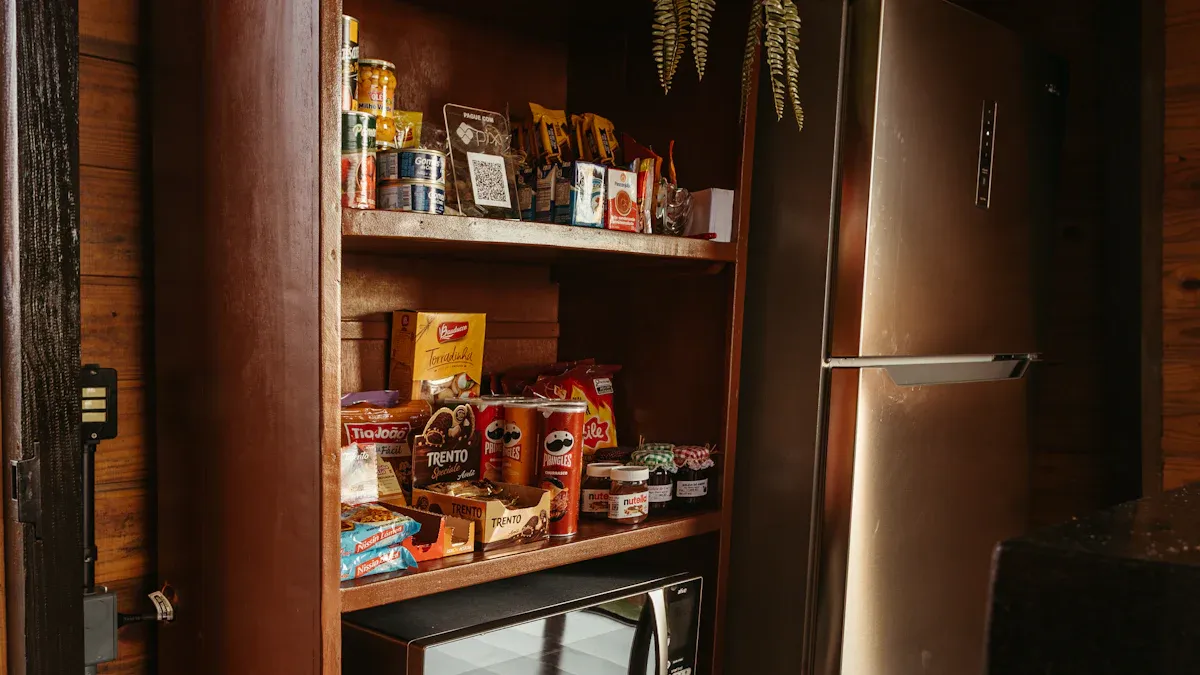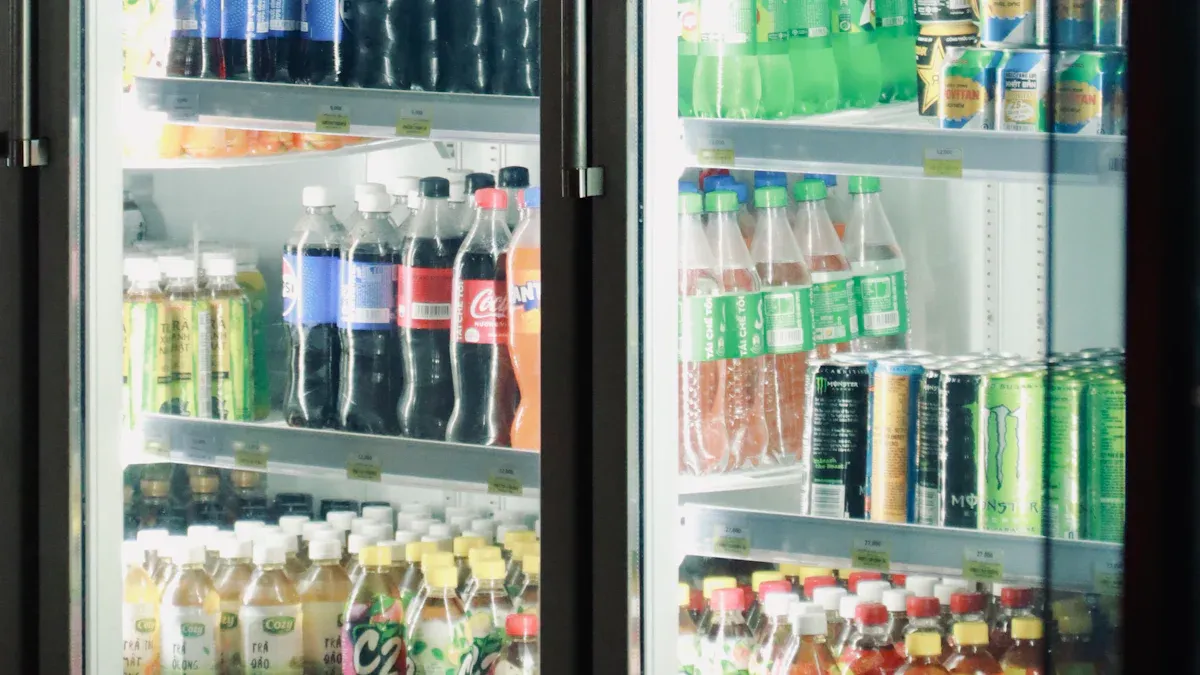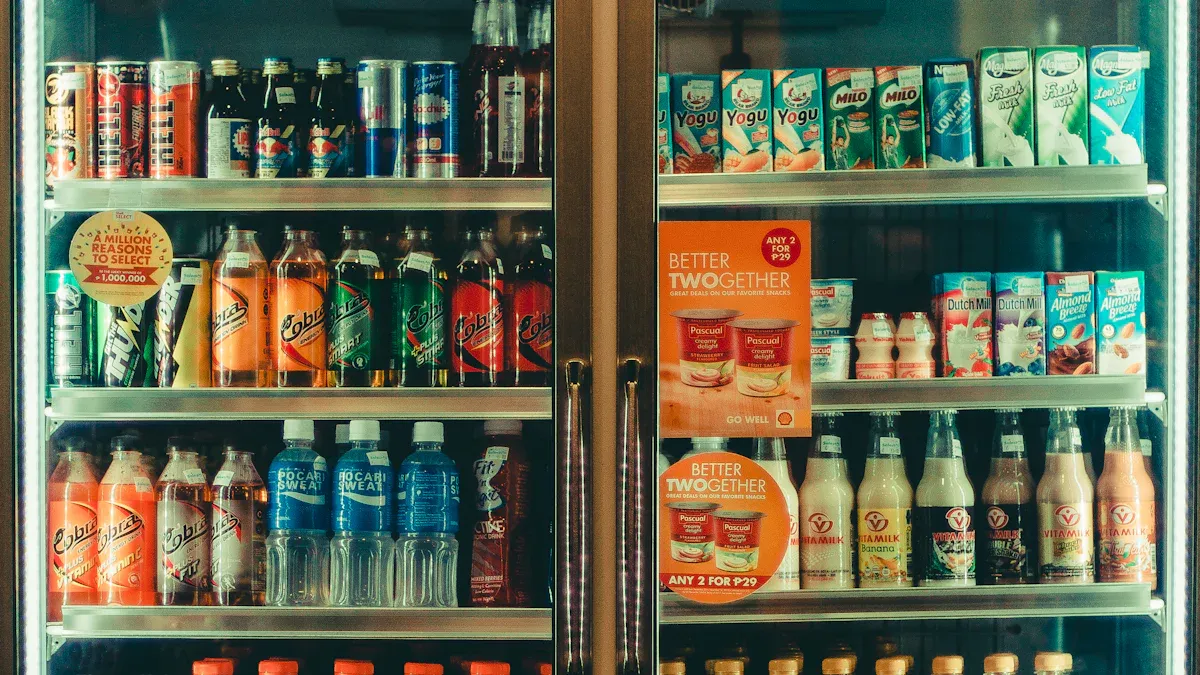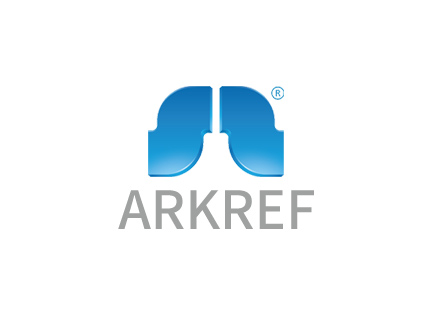How You Can Compare Quick Freezers and Choose the Best One

Looking for the right quick freezer can feel overwhelming, but you’ve got this! With more people buying a freezer to keep up with the growing demand for frozen foods, it’s smart to think about what matters most. The best freezer for you depends on your space, how often you use it, and your budget. Some top factors to consider include:
Freezer type and size
Freezing speed
Energy efficiency
Features and price
Balancing these factors to consider will help you feel confident about buying a freezer that fits your life.
Key Takeaways
Decide what you want to store and how much space you need before you buy a freezer. - Pick a freezer type and size that fits your space and how you use it every day. - Find energy-efficient models to save money and help the environment. - Look for features like quick freeze, temperature controls, and defrost type to keep food fresh and safe. - Use a checklist or table to compare models and read reviews to pick the best freezer for you.
Define Your Needs
Storage Needs
Before you pick a freezer, think about what you want to store. Do you freeze lots of meat, or do you keep fruits and veggies for smoothies? Different foods need different storage methods. For example, meats and dairy need airtight packaging and a steady temperature below 4°C. Fruits and vegetables do better in breathable containers and cool, dry spots. If you pack your freezer too full, you might have trouble finding things or keeping food safe. Overfilled freezers can lead to spoilage and waste. You can use vertical racks or modular storage units to help organize your space. Planning for future growth is smart, too. If you think you’ll need more room later, look for a freezer that can handle extra storage or has options for expansion. Good packaging and stock rotation keep your food fresh and safe.
Space & Placement
Where will you put your freezer? Measure your space before you buy. Freezer size matters more than just fitting in your kitchen. A 10 cubic foot chest freezer works well for small businesses or families and holds about 350 pounds of food. If you buy in bulk or prep meals ahead, you might need a bigger freezer or even more than one. Some freezers are “garage ready,” so they work in places with big temperature swings, like garages. Just make sure your garage is enclosed to protect the freezer from rain or snow. The insulation and design of the freezer help it last longer in these spots.
Think about:
Freezer type (chest or upright)
Freezer size and capacity
Placement (kitchen, basement, garage)
Noise level and maintenance
Usage Frequency
How often do you open your freezer? If you use it every day, you’ll want a freezer that’s easy to organize and quick to access. Some types, like upright freezers, make it simple to grab what you need fast. If you only use your freezer for long-term storage, a chest freezer might work better. Different types of freezers have different features, so match your choice to your habits. If you plan to freeze lots of different foods, look for a freezer with adjustable shelves or bins. This way, you can keep everything neat and easy to find.
Quick Freezer Features

Freezing Speed
Freezing speed is very important when picking a quick freezer. You want your food to freeze fast so it stays fresh. Some freezers have a "quick freeze" button or setting. This makes the freezer colder right after you add new food. It helps keep the food’s taste and texture. Chest freezers freeze food faster because cold air stays inside. Upright freezers lose more cold air when you open the door. They take longer to get cold again. If you freeze a lot of food at once, choose a freezer with a strong quick freeze feature.
Capacity
Picking the right freezer size helps you stay organized. It also stops food from going to waste. You should choose a freezer that fits your needs. Here is a table with common chest freezer sizes:
Freezer Type | Capacity (cubic feet) | Capacity (liters) |
|---|---|---|
Chest Freezer Model 1 | 14.5 | 412 |
Chest Freezer Model 2 | 11.0 | 311.5 |
Most chest freezers are between 11 and 14.5 cubic feet. Upright freezers are about the same size but use shelves and bins. To pick the best size, follow these tips: Think about how much food you freeze each week. A 10 cubic foot freezer holds about 350 pounds of food. This works for a big family or a small restaurant. If you freeze many types of food, you might need a bigger freezer or two freezers. Make sure your freezer fits in your space and has room for air to move around it. Adjustable temperature controls help you keep food safe. Energy-efficient models save you money. Check the warranty and how strong the freezer is, especially for business use. Stay within your budget and look at payment plans if you need them.
Energy Efficiency
Energy efficiency helps you save money and helps the environment. Look for the Energy Star label when you shop for a quick freezer. These freezers use about 20% less energy than regular ones. They have better insulation and smarter motors. Chest freezers usually use less energy than upright freezers. This is because they keep cold air inside better. Even if an Energy Star freezer costs more at first, you will save money on your electric bill every month. Over time, you will save a lot.
Tip: Energy Star freezers are quieter and last longer. Their motors do not have to work as hard.
Temperature Controls
Modern quick freezers have different temperature controls. You can find manual and digital controls. Here is a table to help you compare:
Temperature Control Type | Description | Benefits to Users |
|---|---|---|
Adjustable Thermostat | Lets you set the temperature between -18°C and -22°C | Keeps food safe and fresh for longer |
External Temperature Display | Shows the temperature outside the freezer | Lets you check the temperature without opening the door |
You defrost the freezer yourself | Keeps a steady, cold temperature for better food quality | |
Auto-Defrost (Frost-Free) | Freezer defrosts itself | Less work for you, but may have small temperature changes |
Digital controls let you set the exact temperature you want. They also have alarms if the door is left open or if it gets too warm. Some freezers let you check the temperature from your phone. Digital controls make your freezer safer and easier to use.
Digital thermostats are simple to change.
Quick freeze settings help when you add new food.
Digital displays show the temperature clearly.
Some freezers let you check them from far away.
Defrosting
There are two main types of defrosting: manual and automatic (frost-free). Manual defrost freezers need you to empty them and melt the ice sometimes. This takes more work, but it keeps the inside colder and more steady. Your food stays fresh for longer. Frost-free freezers defrost themselves. You do not have to scrape out ice, which saves time. These freezers use a little more energy and may have small temperature changes. But they are much easier to take care of.
Manual defrost: More work, but better for long-term storage.
Frost-free: Less work, but may have tiny temperature changes.
Note: Frost-free freezers save you time and effort. They also stop ice from building up, which helps the freezer work better.
Safety Features
Safety features keep your food safe and help you worry less. Many quick freezers have alarms if the door is open or if it gets too warm. Some freezers let you get alerts on your phone. Battery backups keep alarms working during power outages. Some freezers even have backup cooling to keep food cold if the power goes out. Not every freezer has a door lock, but many have alarms and smart systems to keep your food safe.
If you store expensive or important food, look for a freezer with strong safety features like alarms and remote monitoring.
Chest vs. Upright Freezers: Which Type Fits You?
Let’s look at the two main types of quick freezers:
Aspect | Chest Freezers | Upright Freezers |
|---|---|---|
Storage | Removable baskets, deep space | Shelves and door bins for easy organization |
Access | Lid opens wide, keeps cold air in | Door opens like a fridge, easy to reach items |
User Satisfaction | Great for small spaces, energy efficient | Saves floor space, frost-free, digital controls, alarms |
Temperature | 360-degree cooling, steady cold | Digital thermostat, even cooling |
Energy | Very efficient, keeps cold well | Efficient, but chest types usually use less energy |
Organization | Takes more effort to organize | Easier to organize and find food |
Chest freezers are good if you want to save energy and store food for a long time. Upright freezers are better if you want to get food quickly and keep things organized. Think about your space, how you use your freezer, and what matters most to you.
Compare Models

Checklist or Table
When you look at different freezer models, a checklist or table helps you compare them fast. Write down what matters most, like size, energy use, freezing speed, and special features. Here is a simple table you can use to look at your top picks:
Model Name | Capacity | Energy Star | Quick Freeze | Defrost Type | Special Features | Price |
|---|---|---|---|---|---|---|
Samsung RS76CG8003B1HL | 700L | Yes | Yes | Frost-Free | Wi-Fi, Twin Cooling | $ |
LG GL-B257HDSY | 650L | Yes | Yes | Auto | Multi Air Flow, Inverter | $ |
Haier HRB-600IS | 600L | Yes | Yes | Auto | Deo Fresh, Convertible | $ |
Candy CSS6600TS | 660L | Yes | Yes | Auto | Convertible, Antibacterial | $ |
You can write your own notes in this table. This helps you remember important things when you shop for a freezer.
Reviews & Ratings
Reading reviews and ratings gives you real opinions from people who use the freezers. You find out what is good and what is not so good. For example, Samsung freezers are known for being reliable and making customers happy. In the J.D. Power 2024 Appliance Satisfaction Study, Samsung is best for warranty, service, and how well it works. People like Samsung quick freezers because they freeze food fast, save energy, and have smart features like Wi-Fi. LG freezers are liked for keeping food fresh and being quiet. Haier and Candy freezers are good for saving energy and having flexible storage. Experts and buyers both say these brands last a long time and do not break often.
Tip: Always read both expert and customer reviews before you buy. Look for things people like or do not like about each freezer.
Priorities
You should decide what is most important before picking a freezer. Some people care most about price, but others want to save energy. Here are some things to think about when you compare freezers:
Adjustable temperature controls help keep food safe.
Energy efficiency saves you money on bills.
Strong build means fewer repairs.
Do not just pick the cheapest freezer. A cheap freezer can cost more later if it uses too much energy or breaks.
Choose a freezer with enough space and good ways to organize, like baskets or dividers.
Think about noise, defrosting, and brand reputation.
Payment plans can help if you want a better freezer but need to pay over time.
When you think about all these things, you will find the freezer that fits you best. Buying a freezer is a big choice, but you can make a smart pick by focusing on what matters most.
Make Your Choice
Weighing Factors
Now you have all the facts, but how do you actually pick the right freezer? You want to make sure you get the best value and the right fit for your home or business. Here’s a simple way to weigh your options:
Look at the most important freezer features. Check temperature control, storage options like sliding baskets or dividers, defrosting type, noise level, durability, and brand reputation.
Think about the trade-offs. Manual defrost freezers need more work but keep food colder. Auto-defrost freezers are easier to use but may have small temperature changes.
Compare the upfront cost with long-term savings. Energy-efficient freezers might cost more at first, but they save money on your electric bill and last longer.
Match the freezer to your space and needs. Make sure it fits in your kitchen or garage and supports your daily routine.
Read user reviews and check brand ratings. This helps you avoid freezers that break down or build up too much frost.
Make a checklist of your top needs. Put the most important freezer features at the top. This helps you focus on what matters most to you.
Tip: Don’t rush. Take your time to compare each freezer side by side. A checklist or table can help you see the differences clearly.
Confident Decision
You’ve done your homework. You know what you want from a freezer. Now, trust your research and your gut. Pick the freezer that matches your needs, fits your space, and feels right for your budget. Remember, no freezer is perfect for everyone, but you can find the one that works best for you.
If you ever feel stuck, go back to your checklist. Ask yourself which freezer checks the most boxes. Sometimes, the best choice is the one that makes your life easier every day.
When you choose a freezer with care, you save money, keep your food safe, and enjoy peace of mind. You’ve got this!
Choosing the right freezer means thinking about what you need most. When you compare each freezer, you avoid surprises and find the best fit for your space. Try using a checklist or table to keep things simple.
You match your freezer to daily and busy times, so you never run out of space.
You pick a freezer that fits your kitchen or garage, making setup easy.
You look for features like easy cleaning and energy savings, which help you spend less time and money.
You choose a freezer that matches your style, whether you want something simple or high-tech.
You get a freezer that works well for your family or business, giving you peace of mind.
Focus on what matters to you, and you will find a freezer that makes life easier. Start your search today and enjoy the benefits of a freezer that truly fits your needs!
FAQ
How do you know what size freezer you need?
Think about how much food you want to store. A good rule is 1.5 cubic feet per person. If you buy in bulk or freeze meals, you might want a bigger size.
Can you put a freezer in the garage?
Yes, you can! Just make sure the model says "garage ready." These freezers work well in places with big temperature changes. Always check the manual for best results.
What is the difference between manual and frost-free defrosting?
Manual defrost means you unplug and clean out ice by hand. Frost-free models melt ice automatically. You save time with frost-free, but manual types keep a steadier cold.
How do you keep your freezer organized?
Use baskets or bins to group foods. Label everything with dates. Keep older items in front so you use them first. This helps you find things fast and avoid waste.
See Also
Selecting The Best Belt Freezer To Fit Your Requirements
Analyzing Tunnel Freezers Through A Competitive Comparison
Deciding Between Cold Rooms And Freezer Rooms For Use
How To Utilize Quick Freeze Compressors In Food Production
Understanding The Main Differences Between Blast And Standard Freezers

